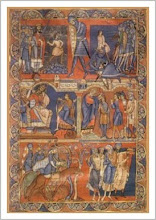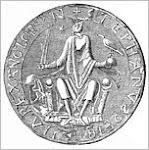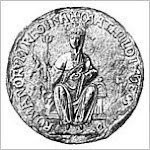• Daily Life - Part I
Feudalism and Medieval life
Feudalism: What does feudalism and all that it entails mean? Find out here
The social structure of the Middle Ages was organised around the system of Feudalism. In practice it meant that a country was not governed solely by the king but by individual barons, who administered their own estates, dispensed their own justice, minted their own money, levied taxes and tolls, and demanded military service from vassals. Sometimes the barons could field greater armies than the king. In theory the king was the chief feudal lord, but in reality the many individual barons were supreme in their own territory.
Feudalism was built upon a relationship of obligation and mutual service between vassals and lords. A vassal held his land, or fief, as a grant from a lord. When a vassal died, his heir was required to publicly renew his oath of fealty to his lord or suzerain. This public oath was called homage. The lord was obliged to protect the vassal, give military aid, and guard his children. If a daughter inherited, the lord arranged her marriage. If there were no heirs the lord disposed of the fief as he chose. A vassal was required to attend the lord at his court, help administer justice, and contribute money if needed. He was required to answer a summons to battle and bring an agreed upon number of fighting men. In addition he was obligated to feed and house the lord and his company when they travelled across his land.
What was life like for ordinary people under this system?
Manors rather than villages were the economic and social units of life in the early Medieval period. A manor consisted of a manor house, one or more villages, and up to several thousand acres of land divided into meadow, pasture, forest, and cultivated fields. The fields were further divided into strips - 1/3 for the lord of the manor, less for the church, and the remainder for the peasants and serfs. At least half of the working days were spent tending the land belonging to the lord and the church. Some time was also spent doing maintenance and on special tasks such as clearing land, cutting firewood, and building roads and bridges. The rest of the time the villagers were free to work their own land. A serf was bound to a lord for life and needed the lord's permission to marry. They couldn't own property or leave the land without the lord's permission. However, in theory at least a serf couldn't be displaced if the manor changed hands, nor be forced to fight, and he was entitled to the protection of the lord. Most families lived in rough huts with dirt floors and no chimneys or windows. One end of the hut was often given over to livestock. Furnishings were sparse and often consisted of little more than stools, a trestle table, and beds on the floor softened with straw or leaves. Their diet was plain and included porridge, cheese, bread, and a few home grown vegetables. Life was hard but people didn't work on Sundays or Saints Days, and they could go to nearby fairs and markets. Generally speaking, daily life was aligned very closely to the seasons eg. sowing and planting time, the harvest etc.
• Notes About Medieval Celebrations:
Medieval celebrations revolved around feast days that had pagan origins and were based on ancient agricultural celebrations that marked when certain crops should be planted or harvested. They also relate to the development of the Christian Church. Below is a short list of feast days and celebrations in the yearly cycle.
* Michaelmas, 29th September - Michaelmas marked the beginning of winter and the start of the fiscal year for tradesmen. Wheat and rye were sown from Michaelmas to Christmas.
* By November, feed was often too scarce to keep animals through the winter, and became known as the "blood month" when meat was smoked, salted and cured for consumption during the long winter ahead. The month began with All Hallows (All Saints) Day, followed by St Martin's Day on 11th November.
* Winter Solstice, 21-23rd December: shortest day of the year, longest night, preparing the soil for Spring.
* Christmas or Yule: The two week period from Christmas Eve to Twelfth Day on 6th January became the longest vacation for workers. The Lord of the manor or castle often gave bonuses of food, clothing, drink and firewood to servants. Houses were decked with holly and ivy, and giant Yule logs were brought in and burned throughout the celebration. New Year's took place during this time and added to the festivities, and "First Gifts" were often exchanged on this day.
* Spring crops would be planted from the end of Christmas through Easter.
* Twelfth Night, 5th January: the end of Christmas festivities and to honour abundance and fertility for the year.
* "Plow Monday" took place the day after Epiphany, and freemen of the village would participate in a plough race to begin cultivation of the town's common plot of land. Each man would try and furrow as many lines as possible because he would be able to sow those lines during the coming year.
* Candlemas, 2nd February: the eve of Candlemas was the day on which Christmas decorations of greenery were removed from people's homes.
* Easter was another day for exchanging gifts. The castle lord would receive eggs from the villagers and in return provide servants with dinner. A lesser celebration was Hocktide, the end of the Easter week. In medieval Britain there was an egg throwing festival held in the churches at Easter. The priest would give out one hard boiled egg which was tossed around the nave of the church and the choirboy who was holding the egg when the clock struck twelve would get to keep it.
* Spring Equinox, March: beginnings and new life
* May Day: marks the end of the winter half of the year, celebrates the spring planting season. May Day, the Rogation Days, Ascension saw celebrations of love, especially on the 1st. Villagers would venture into the woods to cut wildflowers and other greenery for their homes to usher in May and hope for a fertile season.
* Pentecost, or Whitsunday: celebrated 7 weeks after Easter Sunday with a feast of the Church.
* Summer Solstice, 21-23rd June: St. John's Day 24th June, Midsummer bonfires, garlands, longest day of the year and shortest night.
* Lammas, or Feast of St Peter, 1st August: Lammas Day (loaf-mass day), the festival of the first wheat harvest of the year. On this day it was customary to bring to church a loaf made from the new crop. In many parts of England, tenants were bound to present freshly harvested wheat to their landlords on or before the first day of August. In the Anglo-Saxon Chronicle, where it is referred to regularly, it is called "the feast of first fruits".
* Autumn Equinox, September: end of summer and the harvest
• Notes about Medieval Market Towns and Inns:
The term 'market town' is a legal term that originated during the medieval period meaning a settlement that has the right to host markets. This distinguishes a town from a village or city. Market towns were frequently located where there was ready access to transport eg. at a crossroads or close to a river ford and near castles which offered protection. As market towns developed a system was devised whereby a new market town could not be established within a certain travelling distance, usually within one days travel to and from the market, of an existing one.
Traditional market towns usually had a wide main street or central market square which provided room for traders to set up stalls and booths on market days. Sometimes a market cross was erected in the centre of town both to obtain a blessing on the trade conducted and eventually market halls were developed which included administrative quarters on the first floor above the covered market.
Medieval Inns were usually located along main roads and traditionally provided not only food, drinks, and lodgings but also stabling and fodder for a traveller's horse. Inns also acted as community gathering places and, especially in rural areas, provided a place for people to meet, socialise and exchange news.
"Whosoever shall brew ale in the town with intention of selling it must hang out a sign, otherwise he shall forfeit his ale."
Subscribe to:
Post Comments (Atom)








No comments:
Post a Comment